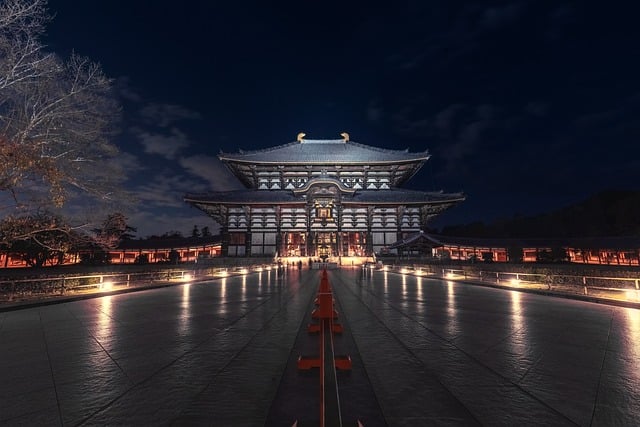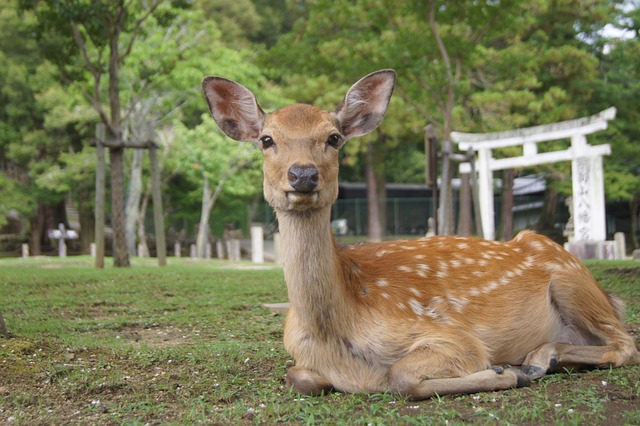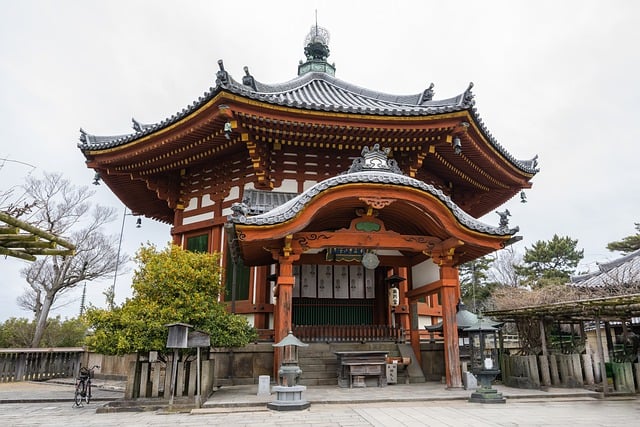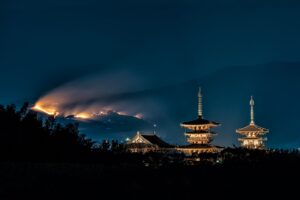Nara is a historic city located in the Kansai region of Japan, known for its rich cultural heritage, ancient temples, and friendly deer. Nara was Japan’s first permanent capital, established in the year 710 AD, preceding Kyoto and Tokyo. During the Nara period (710-794), the city flourished as the center of Japanese politics, culture, and religion. Nara is home to several UNESCO World Heritage Sites, including: Todai-ji Temple: A historic Buddhist temple famous for its Great Buddha Hall (Daibutsuden), which houses one of the largest bronze Buddha statues in Japan. Kasuga Taisha Shrine: A Shinto shrine known for its thousands of stone lanterns and vermilion torii gates, surrounded by a beautiful forest. Kofuku-ji Temple: A Buddhist temple with a pagoda and other historic buildings, offering insights into Japan’s ancient architecture and religious practices. Nara Park: Nara Park is a spacious public park located in the city center, famous for its friendly deer that roam freely throughout the area. Visitors can interact with the deer, feed them special crackers (shika senbei), and take photos with these beloved animals.
Nara features well-preserved historic districts with traditional architecture, narrow streets, and charming shops. Places like Naramachi and Yoshiki-en offer glimpses into Nara’s past and provide opportunities for sightseeing, shopping, and dining. Nara National Museum: The Nara National Museum showcases a vast collection of Buddhist art, sculptures, and artifacts from Nara’s rich cultural heritage. The museum’s exhibits offer insights into the history, religion, and artistry of ancient Japan. Mount Wakakusa: Mount Wakakusa, also known as Mount Mikasa, is a scenic hill located near Nara Park. Visitors can hike to the summit for panoramic views of Nara city, Todai-ji Temple, and surrounding landscapes. Nara Machi: Nara Machi is a charming area lined with traditional machiya (townhouses) and historic buildings. It offers a glimpse into Nara’s Edo period (1603-1868) past and features museums, galleries, cafes, and boutique shops.
Nara hosts various seasonal events and festivals throughout the year, including the Omizutori Festival (Water-Drawing Festival) at Todai-ji Temple in March and the Shikinen Sengu Ceremony at Kasuga Taisha Shrine every 20 years. Nara is a fascinating destination for history enthusiasts, nature lovers, and cultural travelers, offering a blend of ancient heritage, natural beauty, and warm hospitality that captivates visitors from around the world.
- https://www.youtube.com/watch?v=Kbz3E1INyVw
To travel from Osaka to Nara, you have several transportation options. The train is the most popular and efficient mode of transportation for traveling from Osaka to Nara, offering frequent departures and easy access to Nara’s attractions. However, depending on your preferences and schedule, other transportation options may also be suitable for your journey.
Train: The most convenient way to reach Nara from Osaka is by train. You can take either the JR Yamatoji Line or the private Kintetsu Line. (1) JR Yamatoji Line: From Osaka Station or Tennoji Station, take the JR Yamatoji Line bound for Nara Station. The journey takes approximately 45 minutes to 1 hour, depending on the train type. Nara Station is centrally located, making it easy to access Nara’s main attractions. (2) Kintetsu Line: Alternatively, you can take the Kintetsu Nara Line from Osaka-Namba Station or Osaka-Uehommachi Station to Kintetsu Nara Station. This route also takes around 45 minutes to 1 hour. Kintetsu Nara Station is located slightly further from Nara’s city center compared to JR Nara Station, but it’s still within walking distance of major sights.
(3) Bus: There are direct buses operated by Nara Kotsu and other companies that run between Osaka (Umeda or Namba) and Nara. The bus journey typically takes around 1.5 to 2 hours, depending on traffic conditions. Buses depart regularly throughout the day, offering a convenient option for travelers who prefer a direct route. (4) Car: If you’re traveling by car, you can drive from Osaka to Nara via the Hanshin Expressway or the Meihan Expressway. The journey takes approximately 1 to 1.5 hours, depending on traffic. Keep in mind that parking in Nara’s city center can be limited and expensive, so it’s advisable to use public transportation once you arrive. (5) Taxi or Ride-Sharing: Taxis and ride-sharing services are available in Osaka and can provide a convenient but more expensive option for traveling to Nara. Taxis can drop you off directly at your desired location in Nara, offering flexibility and comfort for travelers with luggage or those traveling in groups.
TODAi-ji temple

Todai-ji Temple, located in Nara, Japan, is one of the country’s most famous and historically significant Buddhist temples. Todai-ji Temple was founded in the year 738 by Emperor Shomu during the Nara period (710-794), making it one of Japan’s oldest and most venerable temples. Emperor Shōmu, September 22, 701 – June 4, 756) was the 45th emperor of Japan,] according to the traditional order of succession. Shōmu’s reign spanned the years 724 through 749, during the Nara period. The temple was originally established as the headquarters of the Kegon sect of Buddhism and served as a center of Buddhist learning and worship.
The name “Todai-ji” (東大寺) can be broken down into three parts: Todai (東大): This translates to “Eastern Great.” “Todai” is a combination of the characters “tō” (東), meaning “east,” and “dai” (大), meaning “great” or “large.” Ji (寺): This translates to “temple.” “Ji” is a common suffix used in Japanese to denote a Buddhist temple. Therefore, “Todai-ji” can be understood as the “Eastern Great Temple.”
Great Buddha Hall (Daibutsuden): The main attraction of Todai-ji Temple is its Great Buddha Hall, known as Daibutsuden in Japanese. This massive wooden structure is one of the largest wooden buildings in the world and houses a colossal bronze statue of Buddha known as the Daibutsu (Great Buddha). The Daibutsu measures approximately 15 meters in height and is one of Japan’s most iconic and revered cultural treasures. The Great Buddha statue inside Daibutsuden is an awe-inspiring masterpiece of Buddhist artistry. Cast in bronze, the statue depicts Buddha Vairocana and is seated in the lotus position with its right hand raised in a gesture of fearlessness (abhaya mudra). The Great Buddha is a symbol of enlightenment, compassion, and the eternal truth of Buddhism.
Todai-ji Temple is located within Nara Park, a vast public park known for its friendly Sika deer. Visitors to Todai-ji Temple often encounter deer roaming freely throughout the park, adding to the unique and tranquil atmosphere of the temple grounds. Todai-ji Temple holds significant cultural and historical importance in Japan, serving as a symbol of Buddhist spirituality, architectural excellence, and artistic achievement. The temple has been designated as a UNESCO World Heritage Site and remains a cherished destination for pilgrims, tourists, and scholars alike. In addition to the Great Buddha Hall, Todai-ji Temple complex includes several other notable structures and attractions, such as Nandaimon Gate (Great South Gate), Hokke-do Hall (Sangatsu-do), and the Shoso-in Treasure House, which houses a collection of precious artifacts from the Nara period. Todai-ji Temple is a must-visit destination for anyone exploring the historic city of Nara, offering a fascinating glimpse into Japan’s ancient religious and cultural heritage. Its majestic architecture, revered statues, and serene surroundings make it a truly unforgettable experience for visitors from around the world.
nara park

Nara Park, also known as Nara Deer Park, is a sprawling public park located in the city of Nara, Japan.
Nara Park is situated in the heart of Nara City, covering a vast area of approximately 660 hectares. It is easily accessible from Nara Station and other major attractions in the city. Nara Park is famous for its population of friendly Sika deer, which roam freely throughout the park. These deer are considered sacred messengers of the gods in Shinto belief and have become beloved symbols of Nara. Visitors can interact with the deer, feed them special crackers (shika senbei), and take photos with them. Nara Park is known for its natural beauty, featuring lush greenery, wooded areas, and picturesque landscapes. Visitors can enjoy leisurely walks, picnics, and nature trails while exploring the park’s serene surroundings.
Nara Park is home to several historic landmarks and cultural attractions, including: Todai-ji Temple: One of Japan’s most famous Buddhist temples, known for its Great Buddha Hall (Daibutsuden) housing a giant bronze Buddha statue. Kasuga Taisha Shrine: A UNESCO World Heritage Site known for its thousands of stone lanterns and vermilion torii gates, set amidst a beautiful forest. Kofuku-ji Temple: A historic Buddhist temple with a pagoda and other architectural treasures dating back to the Nara period. In spring, Nara Park is a popular destination for cherry blossom viewing (hanami), as the park is adorned with thousands of cherry trees in full bloom. The sight of cherry blossoms against the backdrop of historic temples and deer roaming freely is truly enchanting. Throughout the year, Nara Park hosts various cultural events and festivals that attract visitors from all over Japan and beyond. These events include traditional performances, tea ceremonies, and religious rituals held at the park’s temples and shrines.
Nara Park offers opportunities for relaxation and recreation, with open spaces, ponds, and gardens where visitors can unwind and enjoy the tranquility of nature. The park’s serene atmosphere makes it an ideal escape from the hustle and bustle of city life. Nara Park is a must-visit destination for nature lovers, history enthusiasts, and anyone seeking a peaceful retreat amidst scenic beauty and cultural richness. Whether you come to admire the deer, explore the temples, or simply enjoy the natural surroundings, Nara Park offers something for everyone to enjoy.
kasuga taisha
Kasuga Taisha is a prominent Shinto shrine located in Nara, Japan. Kasuga Taisha was established in 768 AD by the powerful Fujiwara clan, who played a significant role in the political and religious affairs of ancient Japan. The shrine was dedicated to the deity Takemikazuchi-no-Mikoto, one of the Four Heavenly Gods of Japan, who was believed to protect the city of Nara and its residents.
Kasuga Taisha is known for its distinctive architectural style, characterized by vermilion-lacquered buildings, sloping roofs with curved eaves, and intricate wood carvings. The shrine’s main hall, known as the Honden, and its auxiliary halls are surrounded by a dense forest of cedar trees, creating a serene and mystical atmosphere. One of the most striking features of Kasuga Taisha is its thousands of stone lanterns and bronze lanterns, which line the pathways leading to the shrine. These lanterns are donated by worshippers and organizations as offerings to the deity and are lit twice a year during the Lantern Festivals in February and August, illuminating the shrine grounds in a breathtaking display of light.
Similar to Nara Park, Kasuga Taisha is also inhabited by friendly Sika deer, which are considered sacred messengers of the gods in Shinto belief. Visitors to the shrine often encounter deer roaming freely throughout the grounds, adding to the spiritual ambiance of the area. Kasuga Taisha is designated as a UNESCO World Heritage Site and is recognized for its historical and cultural importance. The shrine has been the site of various religious ceremonies and festivals throughout its long history and continues to be a place of worship and pilgrimage for Shinto followers and visitors from around the world.
Kasuga Taisha hosts several annual festivals, including the Setsubun Mantoro Festival in February and the Chugen Mantoro Festival in August, during which the lanterns are lit to mark the arrival of spring and autumn, respectively. These festivals attract thousands of visitors who come to witness the illuminations and participate in traditional rituals and performances. Kasuga Taisha is a captivating destination that offers visitors a glimpse into Japan’s ancient religious traditions, architectural beauty, and natural splendor. Whether you come to admire the shrine’s architecture, stroll through the lantern-lined pathways, or simply soak in the tranquil atmosphere, Kasuga Taisha is sure to leave a lasting impression on all who visit.
KOFukuji temple

Kofuku-ji Temple, located in Nara, Japan, is one of the country’s most historic and significant Buddhist temples. Kofuku-ji Temple was originally founded in 669 AD by the powerful Fujiwara clan, one of the most influential families in ancient Japan. The temple played a central role in the political and religious life of the capital city of Nara during the Nara period (710-794), serving as the family temple of the Fujiwara clan. Kofuku-ji Temple has been designated as a UNESCO World Heritage Site, along with other historic monuments in Nara. Its rich history, architectural significance, and cultural importance make it a cherished destination for visitors from around the world.
Kofuku-ji features a mix of architectural styles, including traditional Japanese wooden buildings and Chinese-inspired pagodas. The temple complex includes several important structures, such as the Five-Story Pagoda (Gojunoto), the Octagonal Lantern (Toro), and the Central Golden Hall (Chukondo).
The Five-Story Pagoda of Kofuku-ji is one of the tallest wooden pagodas in Japan, standing at approximately 50 meters in height. It is an iconic symbol of the temple and the city of Nara, offering panoramic views of the surrounding area from its upper levels. Kofuku-ji Temple houses a wealth of cultural treasures, including Buddhist statues, paintings, and artifacts dating back to the Nara period. The temple’s collection includes national treasures and important cultural properties that provide insights into Japan’s ancient religious and artistic heritage.
Similar to Todai-ji Temple, Kofuku-ji is located within Nara Park, a sprawling public park inhabited by friendly Sika deer. Visitors to Kofuku-ji often encounter deer roaming freely throughout the temple grounds, adding to the unique and tranquil atmosphere of the area. Kofuku-ji Temple is dedicated to the Buddhist deity Yakushi Nyorai, the Buddha of Healing and Medicine. The temple has long been revered as a place of worship and pilgrimage, attracting devotees seeking blessings for health, longevity, and prosperity. Kofuku-ji Temple stands as a testament to Japan’s ancient religious and cultural heritage, offering visitors a glimpse into the country’s illustrious past and spiritual traditions.
isuIen garden
Isuien Garden is a beautiful traditional Japanese garden located in Nara, Japan. Isuien Garden is situated in the heart of Nara City, near the historic Nara Park and the Todai-ji Temple complex. It is conveniently located within walking distance of many other popular attractions in Nara.
Isuien Garden has a rich history dating back to the Edo period (1603-1868) when it was originally created as part of a larger estate owned by the influential merchant and politician, Michikiyo Kiyosumi. The garden has since been preserved and restored, allowing visitors to experience its timeless beauty and tranquility. Isuien Garden is renowned for its exquisite design, which incorporates elements of both traditional Japanese garden styles, including a kaiyu-shiki teien (strolling garden) and a tsukiyama-shiki teien (hill garden). The garden features lush greenery, meandering paths, serene ponds, and carefully placed rocks and stone lanterns, creating a harmonious and picturesque landscape.
Isuien Garden consists of two main sections: the Front Garden (Kamien) and the Rear Garden (Shimoen). The Front Garden is characterized by its open spaces, expansive lawns, and views of the surrounding mountains, while the Rear Garden offers a more intimate and secluded atmosphere with winding paths, shaded areas, and teahouses. Isuien Garden is particularly stunning during the changing seasons, with cherry blossoms in spring, lush foliage in summer, vibrant foliage in autumn, and serene snowscapes in winter. Each season offers a unique perspective and beauty, making Isuien Garden a popular destination year-round. Within Isuien Garden, visitors can find a traditional Japanese teahouse called Neiraku-an, where they can experience the art of tea ceremony (chanoyu) in a tranquil setting surrounded by nature.
Admission to Isuien Garden is ticketed, with separate tickets available for the Front Garden and Rear Garden. Visitors can purchase tickets at the entrance gate and explore both sections of the garden at their leisure. Isuien Garden is a hidden gem in Nara, offering visitors a peaceful retreat from the hustle and bustle of the city and a chance to immerse themselves in the timeless beauty of traditional Japanese garden design. Whether you’re a nature lover, a photography enthusiast, or simply seeking a moment of tranquility, Isuien Garden is a must-visit destination in Nara




